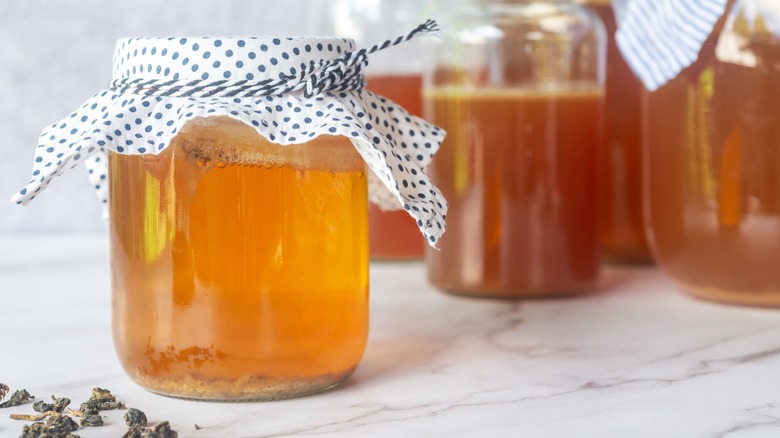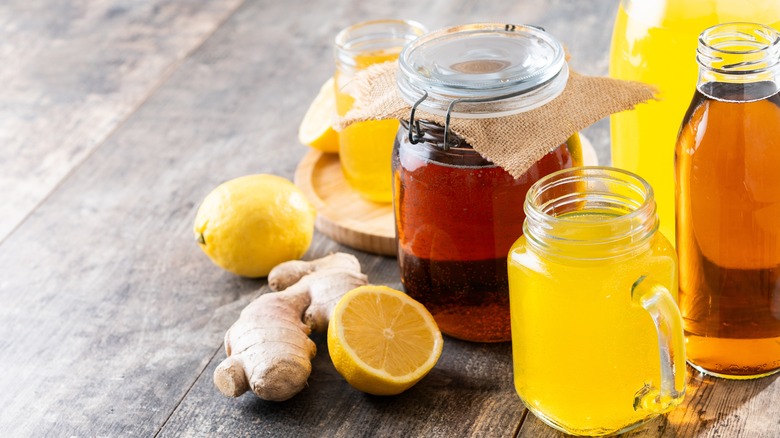What That Cloudy Residue In Kombucha Really Is
Originating in China around 2000 years ago, kombucha — a sweet, fermented black tea drink — has been around for quite some time. Despite its long history, it only really skyrocketed in popularity in the U.S. in the early 21st century, thanks to its strong association with potential benefits such as antibacterial properties and probiotics linked to gut health. It now comes in countless flavors from countless brands, and can even be a water alternative to splash into smoothies. One element an authentic batch of kombucha will always contain is a cloudy sediment. While it may not be the most appealing sight, this residue is completely harmless and actually reflects the many benefits of the fermentation process. To better understand what it really is, Food Republic consulted Janelle Bober, team lead and registered dietitian nutritionist at Dietitian Live.
"The cloudy sediment in kombucha is a product of fermentation — it's typically from the inactive yeast that settles over time, and they're typically brown or gray particles, but they're harmless byproducts," she tells us exclusively. During fermentation, sweet tea is fermented with SCOBY (a culture of bacteria and yeast.) The yeast cells break down sugar in the tea and produce carbon dioxide and ethanol as natural by-products. As this process progresses, some yeast cells become inactive and group together, become heavy and fall to the bottom of the drink, which is where you will usually find this residue settled. "It's not usually mold or spoilage, but it's proof that the beverage you're making is fermenting," Bober adds, so if you see this in your kombucha, take it as a sign that the drink has properly fermented, and you're getting to enjoy all the natural benefits that come with it.
Harmless residue or spoilage?
What you might not have known about kombucha is that not everything floating around in it is cause for concern. In fact, most of what you'll see at the bottom of your bottle is perfectly normal. "The harmless sediment will naturally fall and have that stringy cloud-like texture at the bottom of the bottle. It's inactive and completely safe to consume," registered nutritionist Janelle Bober tells Food Republic exclusively. This residue is not an indication of spoilage, and is instead an indicator that the fermentation process has taken place. However, like any perishable, kombucha won't stay fresh forever after opening, and there are some signs that it's taken a turn for the worse.
As opposed to the brown or gray particles, which are by-products of fermentation, "spoilage ... will have mold — you'll see fuzzy, discolored particles that are typically white, green, or blue, and it's found floating around the surface," Bober says. So color and position of the particles are the key indicators of whether the residue is harmless or an indicator of spoilage. To distinguish harmless residue from spoilage, Bober provides a fool-proof metric to follow: "Harmless sediment is going to be at the bottom and harmful or spoilage is going to be at the top."
If you want to be extra-certain, you can also employ a smell test. "If it's spoiled, it might have an off odor. Kombucha has a normal tang to it, but if it's super sour with a very strong smell that smells bad, that's spoilage," Bober warns. Foul odors are your body's natural defence mechanism against consuming spoiled produce, so if the kombucha smells bad, we recommend giving it a skip.
Does sediment affect flavor or provide nutritional benefits?
For a drink made famous for its variety of nutritional benefits, it's fair to wonder if the sediment contains any benefits of its own, or if it influences the flavor of the kombucha in any way. According to dietary nutritionist Janelle Bober, however, the sediment has minimal impact on flavor and nutritional value — if any at all.
"Sediment generally adds texture, not flavor, so a lot of people won't notice the flavor specifically," she shares in an exclusive chat with Food Republic. The main flavor you'll get from kombucha is the tangy, tart, and sweet fizz that results from the fermentation process, with the sediment not contributing anything. "In terms of nutritional value, the sediment doesn't contain too many nutrients — it might have some trace amounts of vitamins and proteins, but the inactive yeast in the sediment doesn't contribute to the probiotic activity. It's the live activated culture from the fermentation process that provides the benefits from kombucha," Bober adds. Remember, the sediment is literally dead yeast cells, so it contains none of the live bacteria or probiotics which are what the nutritional benefits of kombucha stem from.
As the sediment has little impact on the flavor and nutritional value of kombucha, you can easily remove it if you find it off-putting. One of the easiest ways is to "just strain it out," Bober explains. "You could also just gently swirl the bottle if you're okay with mixing it up a little bit," which incorporates the sediment into the drink, making its texture less noticeable.



